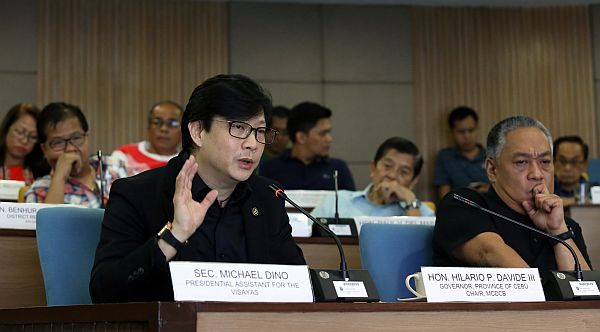
Michael Dino (left), Presidential Assistant for the Visayas, discusses the need of a Light Rail Transit (LRT) in Cebu as an efficient mass transport system as he speaks during the Mega Cebu leaders convergence meeting .
CDN PHOTO/JUNJIE MENDOZA
A Light Rail Transit (LRT) project in Cebu will be among the big-ticket projects to be implemented during the administration of President Rodrigo Duterte.
Presidential Assistant for the Visayas Michael Dino said an LRT system in Metro Cebu can be an efficient form of mass transport system and help address its worsening traffic conditions.
Speaking during yesterday’s Convergence of Mega Cebu Leaders, Dino said there are already several private groups, and even the Chinese government who have expressed interest in developing an LRT system in the province and are now conducting initial tests and studies for the project.
“In fact, we’re waiting for a certain company who would do maybe an unsolicited proposal. I think in a matter of a month or two, I think the proposal will begin. So let’s wait and see. LRT will happen soon. It will really happen in this administration,” he said.
Dino also said an LRT system is not anti-poor, contrary to opinion of some detractors.
He said that he read in the papers about somebody commenting that an LRT in Cebu will be anti-poor.
He explained that it will eventually be the poor and the regular people who will benefit if there will be an LRT system in Cebu.
“I cannot understand because it’s very clear. Kinsa man ang naggamit sa LRT sa Manila? Ang mga dato ba or ang mga pobre? (Who are using the LRT in Manila? The rich or the poor?) I just want to put things in proper perspective. Ang mogamit ana, dili man siguro ang mga dato. Ang mga pobre man siguro (Those who will use it are probably not the rich, it’s probably the poor),” he said.
Earlier this week, Cebu City Mayor Tomas Osmeña made a public pronouncement that he will only support an LRT project in Cebu if the city government will not spend money for it.
Osmeña, who is not exactly very friendly with Dino, said though that in his opinion, only the rich will be able to afford the LRT and that “the poor will remain living below the bridges.”
But Talisay City Mayor Eduardo Gullas said he will continue to support the implementation of an LRT project in Cebu.
He said that when he was first district representative, he authored House Bill 1588 to establish and organize a Cebu LRT Authority during the 10th and even the 11th Congress.
“Bangkok, Thailand used to have an awful traffic, much more awful than we can think of in Cebu. They built an LRT and the traffic normalized,” Gullas said.
Cebu City and the Department of Transportation (DOTr) are currently implementing the P10-billion Cebu Bus Rapid Transit (BRT) project, another mass transport system in Cebu City.
Although he is strongly pushing for the LRT in Cebu, Dino did not expressly say he will oppose the BRT project.
The presidential assistant recalled that in one forum he attended, representatives of the Japan International Cooperation Agency (JICA), mentioned that no matter how many bridges are constructed or roads opened and widened, there will still be choke points.
This is why, he said an efficient mass transport system should be established to address the ever-growing traffic concerns in Metro Cebu and that “we need this LRT.”
Dino said that he is suggesting that if there will be a bidding for the LRT proponent, it should be the bidder that offers the lowest fare rates that should be declared the winner. This way, people can’t say that LRT fares are too high.
“It’s about time we ask these things (big infrastructure projects) from the government. We have to wake up and really do something about it. I hope everyone will support the LRT. It will be at no cost to the government. Hopefully, under PPP (public-private partnership),” Dino said.
He cited as an example the P50-billion Metro Cebu Expressway which will connect Naga City in the south to Danao City in the north. Construction of the 74-kilometer expressway is expected to start next year.
Dino said he pushed for the project because the last major infrastructure spending for Cebu was the Marcelo Fernan Bridge, which started during the time of former president Fidel Ramos and was completed at the term of former president Joseph Estrada.
Bypass and diversion
Meanwhile, other local initiatives should also be done by local government units and groups like the Mega Cebu.
Cebu 1st District Rep. Gerald Anthony Gullas said that while the national government focuses on major infrastructure projects to solve traffic including the widening and improvement of national roads, local officials should also help by opening diversion roads away from national highways.
“If we can include recommendations on more bypass roads because if we can do a lot of these, development will improve in other areas as traffic can improve,” Gullas said.
He cited the traffic problems in Minglanilla town, saying if diversion roads are opened, vehicles can use these instead of the highway in order to ease traffic congestion.
More importantly, these areas are barangay or municipal roads which are not part of the national government’s responsibility and can be locally funded by the municipality, city or province where it is located.
Last March, Gullas said representatives of the Department of Public Works and Highways (DPWH) visited his district to start preparations for a feasibility study on a Talisay-Minglanilla-Naga bypass road.
He said DPWH Secretary Mark Villar told him that the project will cost P15.5 billion.